Abstract
The study is devoted to the problem of maintaining and effectively using the image of the energy company as an employer. The study was carried out on the example of the Kursk nuclear power plant. The designated nuclear power plant is one of the largest plants in Russia in terms of installed capacity and number of employees. According to experts, vacancies in the field of nuclear energy remain one of the most difficult to obtain and, at the same time, in demand on the labor market. In the context of a decrease in demand among the modern youth audience for engineering professions and the demographic crisis, the problem of a shortage of highly qualified personnel in the industry will become urgent in the near future. Based on the analysis of the current personnel policy of the nuclear power plant, expert interviews, analysis of the company media image, the main factors that determine the perception of the personnel of their employer are identified. Three main components of achieving positive results in the indicated direction have been identified. These include effective communication, timely monitoring of employee feedback and the creation of a digital educational environment.
Keywords: HR-brand of an energy enterprises, media image of an enterprise, personnel management in the electric power industry
Introduction
The development of the global economy in general and the service sector in particular creates additional opportunities for job seekers in terms of choosing an interesting job offer for them. The emergence of recruiting agencies, which are intermediaries in the labor market, and provide services to job seekers, and to employers in the selection of personnel, acts as an additional condition for increasing migration flows at the employment exchange.
In these circumstances, the employer becomes vulnerable: the prospect of losing existing qualified employees turns out to be natural. It is possible to minimize its own risks only if the organization considers the management of its image as an employer as a strategic vector of development. An organization with a reputation for widespread public recognition can afford to attract the best talent with less material and time and offer attractive conditions for existing employees while reducing employee turnover.
The very concept of HR branding (from the English employer branding) was first described in 1996 by Tim Ambler and Simon Barrow in the American scientific "Journal of Brand Management" and presented as a combination of economic, psychological and emotional advantages of the employer, which are identified with him. In the foreign literature, initially this definition was interpreted as "a set of features (often intangible) that make an organization special and attractive for employees and job seekers, contribute to the establishment of a connection between them, and ensure the effective work of personnel" (Walker & Higgins, 2007, p. 163).
Modern approaches to the definition of the term "HR branding" and its derivatives have a more detailed formulation. For example, researcher Arkova interprets the term as "a system of images, ideas and ideas about the organization as an employer transmitted to external and internal audiences" (2011, p. 63).
Ivanova (2012) believes that the HR brand is:
A well-known image that has developed among the working and potential employees of the organization, the public, representatives of the professional community, recruiting companies, government services (for example, employment), commercial companies in relation to an organization with unique qualitative characteristics in the labor market, brought to the consciousness of existing and potential employees in such a way that once they enter a job in this organization, they become its adherents. (p. 4)
Based on the analysis of the above definitions, we can conclude that the HR branding of a company means a set of measures aimed at creating a positive image of the employer in the labor market. At the same time, the HR brand represents the image and reputation of the employing company in the minds of current and / or potential employees.
In practice, there are two possible scenarios for constructing an organization's brand as an employer: realistic and idealistic. The first is based on the value proposition and existing characteristics of the company. A promise (value proposition) can be tangible and intangible values that an organization can offer to its employees. The idealistic approach is more costly and time consuming. It implies the introduction of new, previously non-existent practices: modern projects and approaches, the development of which is carried out on the basis of diagnosing the needs of the target audience (current and potential employees), which are spontaneous and changeable (Hr-director, 2020).
The HR branding of a strategic enterprise has traditionally been based on a realistic approach. In this situation, a set of benefits that the employer broadcasts to his employees, based on the synthesis of material and non-material mechanisms of motivation, acquires priority importance (Mullakhmetova et al., 2020).
Problem Statement
According to experts, vacancies in the field of nuclear energy remain one of the most difficult to obtain and, at the same time, in demand on the labor market. In the context of a decrease in demand among the modern youth audience for engineering professions and the demographic crisis, the problem of a shortage of highly qualified personnel in the industry will become urgent in the near future. In this situation, a promising area of research is the study of algorithms and tools for the formation of a managed image of an enterprise as an employer, which will keep existing employees in their workplaces and attract potential ones (RBC, 2020).
The empirical material of the study is the experience of organizing the Russian nuclear power industry. According to the annual report of BP Statistical Review, the share of nuclear energy in global primary energy consumption in 2019 was 4.3 %, in electricity generation – about 10.4 %. In general, nuclear power plants in the world produced 2,796 billion kWh of electricity. In terms of generation, Russia now ranks fourth in the world after the United States, France and China. At the moment, there are 11 nuclear power plants in the country, including a floating one (all are part of Rosenergoatom Concern JSC, which is part of Rosatom State Corporation) (BP, 2020). There are 38 power units in operation with a total installed capacity of 30.3 GW, which is 8 % of the world's total nuclear power capacity. In 2019, nuclear power generation accounted for 19 % of the total generation in the country.
Today, the average number of employees at a nuclear power plant is 3,212 people. As of 2019, the share of young employees under 35 is 44.1 % of employees. The summary statistics actualizes the task of HR branding with internal target audiences (current employees) at nuclear energy enterprises: investments in young employees are directly proportional to the economic efficiency of the NPP operation.
Research Questions
A stable and efficient innovation-type economy is created, first of all, by engineering and technical professionals. However, the current state of the labor market still does not meet this demand. Yesterday's graduates of technical specialties, who could join the ranks of young specialists in engineering specialties, demonstrate a reduced demand for work in their specialty in the industrial and manufacturing sector in general and nuclear energy in particular.
It should be noted that it is not only Russia that is experiencing difficulties with the training of engineering personnel and making up for the shortage of engineers, this phenomenon is by no means a local one. A similar situation is typical for a number of leading and developing economies of the world. In particular, in the UK, this problem is regularly covered in leading national publications as one of the most relevant and top priorities for the country's economy. In addition, according to a survey conducted by one of the local headhunting agencies, in the fourth quarter of 2017, 22% of the country's engineering companies identified the shortage of qualified engineering personnel as one of the main problems in the next few years. The aerospace and aviation industry of foggy Albion is experiencing a particularly acute shortage of personnel: 42% of the leaders of these industries indicated this problem as one of the most significant.
The global nature of the identified problem is confirmed by the fact that 2018 was declared the Year of Engineering by the UK government. And to a large extent, this propaganda campaign was, of course, focused specifically on the younger generation of the British.
The fact of the difficulty of attracting engineering personnel to enterprises in the conditions of various countries, including the most developed ones, is confirmed by the presence on the international market of a whole niche of specialized agencies engaged exclusively in the selection of specialists in technical specialties (for example, VHR, RISEtechnical Michael Page, etc.). Moreover, on the official websites of many of them, the problem of shortage of personnel is designated as the most acute and intractable.
The above review of the global trend of shortage of demand for engineering specialties actualizes the main research question: what employee value proposition is the nuclear industry ready to formulate for current employees and potential employees?
Purpose of the Study
The purpose of the study is to analyze the HR-brand (internal and external components) of a nuclear power plant as an employer in the minds of existing employees; methodologically, it includes the following sequence of actions. To achieve the goal, the study used the following research objectives:
Conducting a sociological survey in order to diagnose the current image of the company in the minds of existing employees
Conducting a desk study aimed at analyzing the current social policy of the company
Conducting an expert interview with employees of the company, allowing you to study the internal motivation of employees in the company
Carrying out media monitoring in order to reconstruct the company's media image created by the media.
Research Methods
All studies were carried out on the material of the Kursk NPP. The choice of the Kursk NPP as a case for the study is explained by the key role of this facility for the entire electric power industry of Russia. In addition, Kursk NPP is one of the largest employers in the country in the nuclear energy segment (Table 01).
Kursk NPP is the most powerful energy complex in the Black Earth Region and one of the largest in Russia. The station operates 4 power units with RBMK-1000 channel reactors with a total capacity of 4 GW. Two stages of KUNPP (2 power units each) were commissioned in 1976–1985. The Kursk nuclear power plant is one of the first four nuclear power plants of the country equal in capacity. The main activity of the enterprise is the production and supply of electricity and heat. The NPP accounts for about 96 % of the installed capacity of all power plants in the region. The station is the most important node of the Unified Energy System of Russia. 80 % of the generated electricity goes to the Center energy system, which supplies 19 regions of the Central Federal District and neighboring Ukraine.
The Kursk nuclear power plant is located southwest of the city of Kursk, on the left bank of the Seim River. Kurchatov is the satellite town of the station three kilometers from the station. The enterprise has been in operation since 1976.
The current image of the NPP in the minds of the current employees. The cumulative sample of the sociological survey was 164 employees of the Kursk NPP aged 18–35 years with experience in the engineering and industrial field. According to the personnel department, as of 04/12/2021, the Kursk NPP has 1,500 young employees. The general population of the study is 4,500 people employed at the enterprise. The confidence level of the obtained sample is 90 %. The margin of error is 6 %.
Among the interviewed respondents aged 29–35, men make up 56 %, women – 20 %. Educational level of all respondents: 86 % have higher education; further in frequency are specialized secondary or secondary technical education (8 %), incomplete higher education (6 %). Duration of work at the NPP: 47 % of employees have been working at the plant for more than 10 years; 25 % work from 5 to 10 years, 13 % of respondents – from 1 to 3 years, 10 % are plant employees for 3–5 years, and only 5 % of respondents have recently joined the ranks of nuclear scientists and have been working at the plant for less than a year.
Among the main groups of motives for working at NPPs, respondents name predominantly material ones: regular wages (76 %), stability and reliability of the enterprise (73 %), convenient schedule (63 %), decent wages (59 %), good organization of working conditions (58 %) (Figure 01).
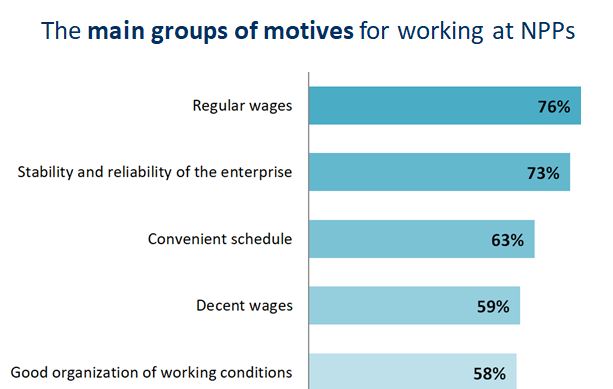
At the same time, 90 % of respondents are confident in their future and do not plan to change their place of work in the near future. In many respects, the decisions of the respondents were influenced by the crisis situation – the spread of coronavirus infection.
According to experts, at the end of 2019, out of 1 million 81 thousand enterprises, 172 thousand were in the “extinction” stage. While the Russian state holding, which unites more than 400 enterprises of the nuclear industry, in particular, the Kursk nuclear power plant has passed the period of the pandemic with dignity: employees were paid their wages in a timely manner and in full, and additional material assistance was provided to those sick.
With regard to the motivation of a group of young specialists, the respondents named good relationships in the team (92 %), the possibility of moving up the career ladder (7 %) and assistance to young employees at the start of their career (68 %) (Figure 02).
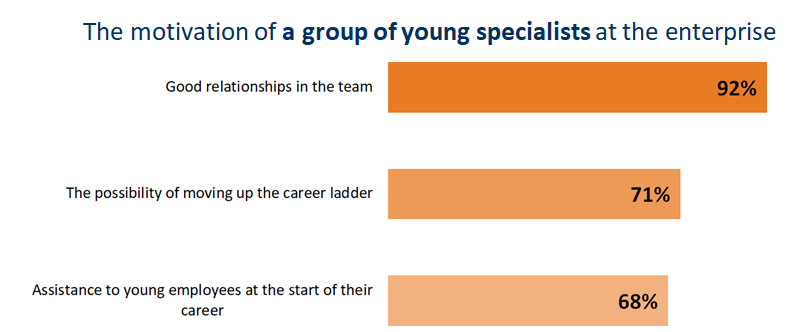
Among the reasons that influenced the choice of a nuclear power plant as a place of work, young specialists name regular wages (78 %), enterprise stability (76 %) and social benefits (69 %) (Figure 03).
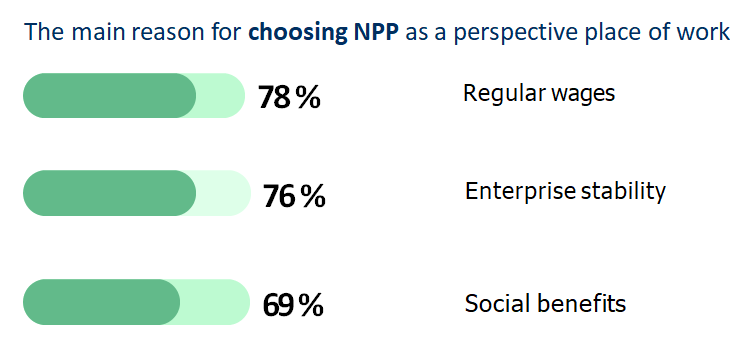
In the structure of the Kursk NPP there are more than 50 subdivisions, including technological, functional and service ones. The technological ones include a reactor shop, a turbine shop, an electrical shop, a chemical shop, a heat automation and measurement shop, a supply systems shop, and a hydrotechnical shop. The functional ones include a personnel service, training centers, a finance and accounting department, etc. The work supply department is separated from the Kursk nuclear power plant and is called Kursk NPP-Service LLC.
The division provides medical and preventive nutrition services, transportation, decontamination of industrial premises, PPE, equipment, catering, is engaged in the production of bread and sausages, fishery and retail trade of semi-finished meat products, and provides cleaning and hotel services.
In addition, the service organization includes a public service – UIOS, which has been engaged in information and educational activities of the enterprise since 2002. Successful implementation of social policy at an enterprise is not possible without an internal communication system. The loyalty of the staff and their desire to work will depend on how effectively and harmoniously the communication is built in the organization (Terentyeva, 2008).
The internal communication system at the Kursk NPP includes a wide range of tools: information boards and stands, an answering machine, TV panels installed in places of mass presence of plant personnel, an internal radio station, and a weekly corporate newspaper “For Peaceful Atom”. The channel of interaction between personnel and management is a local network – an intranet, which allows you to exchange and share information.
The empirical material for the desk study was the fundamental documents at the NPP: a social program, a consolidated action plan for 2021 for young people with the participation of the Kursk NPP, printed and presentation materials of the Education and Career exhibition posted on the official website of the power plant.
Support programs for Kursk NPP employees are distinguished by a wide range of benefits for both young specialists and employees with many years of experience and include 8 main areas: 1) voluntary medical insurance for employees; 2) insurance against accidents and intractable diseases; 3) spa treatment for employees, their family members and children; 4) assistance in improving housing conditions; 5) provision of additional material assistance; 6) providing assistance to employees when living in temporary housing; 7) non-state pension provision; and 8) organization of sports and cultural and recreational activities.
The Kursk NPP has a practice of non-financial incentives and support for active employees: awarding letters of gratitude, gratitude, publication of photos on the honor board of workers in the event that they achieve high performance indicators. The NPP management develops professional platforms for the internal growth of employees: the annual competition "Best Employee of the Year", the championship of professional skills "REASkills".
In the nuclear power industry, the mechanism of material incentives for employees is widely used. According to the Russian newspaper, engineers can receive up to 50 thousand rubles a month. at the start, while the wages of skilled workers vary from 90 to 135 thousand rubles. Professionals of rare engineering specialties with work experience can receive over 220 thousand rubles. per month, and this figure is not the limit.
In 2019, the salary at the Kursk NPP of novice specialists with a higher technical education was 40–50 thousand rubles per month, and an employee with many years of experience at the station in a high position can receive over 250 thousand rubles per month (Table 02).
The expert interview was conducted as part of the study in the period from 21.04.2021 to 23.04.2021 and includes the results of communication with the employees of the Kursk NPP:
- Expert # 1 – Environmental Protection Engineer LLC 41–27, 10 years of experience at the station. Specialty by education: environmental engineer, age 34 years.
- Expert No. 2 – an electrician for maintenance of relay protection and automation equipment, work experience at the station for 1.5 years. Specialty by education: electricity and electrical engineering, age 22 years.
- Expert # 3 – shift supervisor of the chemical department, 8 years of experience at the station. Specialty by education: heat and gas supply and ventilation, age 32.
The purpose of the expert interview was to identify the internal motives for choosing a profession and subsequent employment at a nuclear power plant. According to the methodology for conducting an expert interview, the experts were asked to familiarize themselves with the topic and problem of the research, then – to answer the questions.
Based on the results of the method, it was possible to find out that the choice of a future profession was influenced, first of all, by the years of study in the senior grades of the school. So, for example, expert # 2, while still a schoolboy, actively took part in competitions, among which he remembered the Olympiad in ecology most of all.
Personal abilities and interest in the field of activity after the Olympiad became the reason for choosing a professional direction – "environmental engineer". Expert No. 1 clarified that the school subject of physics, in particular the direction of "electrical engineering", significantly influenced his decision about his professional future. Expert No. 3 also calls the school as the main platform for choosing a future profession, while referring to the example of friends and relatives, in whose footsteps he followed.
On the question of the advantages of working at the station, the opinions of the interviewees agreed. The stability and prestige of the organization, great career prospects and decent material support: high wages and a good social package are essential advantages of working at the Kursk NPP. Thus, expert # 2 believes that only a small number of enterprises in the country provide employees with such a set of advantages as Rosatom. In particular, the crisis situation in connection with the pandemic once again proved the stability and sustainability of the enterprise as an employer.
As for the disadvantages of working at the enterprise, the experts do not single out such, but on the contrary note a number of other advantages within the organization: literacy and politeness of managers, friendly staff and their high level of professionalism and commitment to work.
The only disadvantage, which, according to experts, is also an inseparable advantage, is the complexity and responsibility of the work itself. A nuclear power plant, as a strategically significant enterprise, includes rather complex mechanisms of work, on the correct implementation of which, first of all, the safety and life of many people depends. As noted by expert No. 3, not everyone can do a high level of attentiveness, composure and responsibility.
All experts, without exception, claim that the prospects for work at the enterprise are definitely colossal. Today, the NPP-2 under construction objectively needs highly professional personnel and will need at least the next 50 years.
The media play a key role in shaping the media image of a large industrial enterprise as an employer. To this end, the management of the Kursk NPP carefully monitors the information flows of the divisions, which makes it possible to adjust the media image of the nuclear power plant.
Media monitoring was carried out for the period from 17.04.2020 to 17.04.2021 using the analytical program developed by Medialogia. The empirical base of the study was made up of 7,955 reports on the Kursk NPP. In the media space, the relative stability of filling with content has been recorded. Of the total number of reports, in 3,997 cases, the Kursk NPP plays the main role, in the rest it plays a secondary role.
Distribution of mass media by type of channels: 221 (2 %) reports in newspapers, 52 (0.5 %) – in magazines, 232 (3.5 %) – news agencies, 7,338 (92 %) – Internet, 107 (2 %) – TV programs and an insignificant part – 5 messages – on the radio (Figure 04).
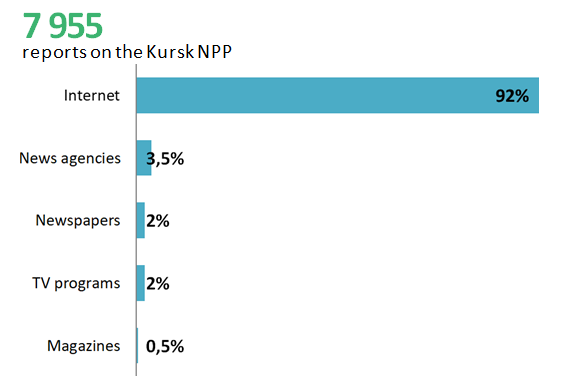
Among the leading media outlets, which regularly publish information about the enterprise and its activities, one can highlight, first of all, the official Internet sites and information portals of Rosatom, as well as the Rambler / news media portal, the Moskovsky Komsomolets Internet newspaper ", The official websites of the Administrations of Kursk and Kurchatov, the daily newspaper Vechernyaya Moskva, the industry magazine Regional Energy and Energy Saving, the Internet news publication Lenta.ru, and others.
In terms of the tonality of messages, neutral messages prevail in the media 88 % (6,999 messages), positive 10 % (836 messages) and negative 2 % (120 messages) (Figure 05).
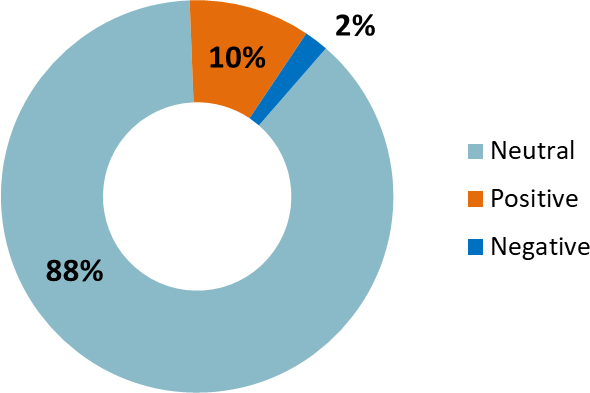
The appearance of negative publications is associated with technical problems – the shutdown of power unit No. 3 of the Kursk NPP due to minor malfunctions, no casualties among personnel were recorded. In addition, the increase in the number of negative reports is associated with the epidemiological situation in Kurchatov, the satellite city of the Kursk NPP, which accounted for ½ of all negative publications. It is known that many of the station's employees were in serious condition as a result of infection with the coronavirus infection.
Almost 2/3 of positive reports are connected with the construction of Kursk NPP-2 to replace power units No. 1 and 2 of the plant after the end of their service life. The implementation of a large-scale project involves the construction of new generation VVER-TOI power units with increased safety and improved technical and economic characteristics. Another positive informational reason was the assistance of the Kursk NPP to the medical and sanitary part of the city, including the purchase of high-tech and expensive equipment and the renewal of the vehicle fleet for the operation of the outpatient clinic.
The geography of distribution of messages about the enterprise is quite extensive. Mostly news appears in nearby cities and regions, which include Moscow, Kursk region, Voronezh, Belgorod, Rostov regions. In addition, high distribution coverage is observed in St. Petersburg and the Sverdlovsk region – territories that are located a thousand kilometers or more: a nuclear power plant (Leningrad NPP) is located in the Northern capital, and the city of Yekaterinburg is famous for its metallurgical industry.
The media image of the enterprise is an integral component of the HR branding strategy as a whole, broadcasting the key priorities of the enterprise's work with employees and the development of the territory where the production complexes are located. With the help of communication tools, public opinion is being formed regarding the Kursk NPP as a socially oriented enterprise, the central task of which is the well-being of the plant employees and residents of the city of Kurchatov.
Findings
A managed HR brand includes a set of components verified on the empirical basis of Russian NPPs, including: an internal image (focused on existing employees) and an external image (focused on potential job seekers).
The presented analysis of the internal image of a nuclear power plant allows us to formulate the categories of the employer's value proposition, broadcast to the external audience of potential employees (Table 03).
A detailed formulation of the value proposition of a nuclear power plant as an employer, together with properly selected channels for broadcasting a key message to target audiences, can partially solve the problem of creating a positive image of engineering professions among young people.
According to data for 2020, Rosatom topped the annual rating of the best employers in Russia. Tatiana Terentyeva, General Director for Human Resources of the State Atomic Energy Corporation Rosatom, identified three factors as factors that influenced this result: effective communication, timely monitoring of employee feedback and the creation of a digital educational environment.
Optimization of internal communication made it possible to conduct weekly video messages from the CEO for employees and residents of cities where the nuclear power plant is located, pulse polls to understand the current state of employees and their loved ones, psychological assistance and online training. As part of digital learning, various formats have been implemented from the usual webinars and conferences to special programs for families and children of employees, such as Children's Academy, ART-family, Atomic Charge in the morning, which has become one of the most popular formats along with courses English and work in distributed teams.
Conclusion
The problem of shortage of engineering personnel is becoming relevant in many developed and developing countries. The fact that even the most prosperous and industrialized countries accept, in order to reduce its importance, state programs for information support of the system of higher and secondary engineering education and the promotion of the image of industrial and technical professions, suggests that the problem is beginning to experience a new phase. In fact, we are talking about strengthening global and intercountry competition for qualified engineers. A clear evidence of this is the opening in the countries of Western Europe of a number of specialized recruitment agencies engaged in the selection of personnel exclusively for manufacturing corporations.
The experience of the Kursk NPP considered in the article made it possible to develop a layout of the employer's value proposition as one of the tools for constructing a managed image of a nuclear power plant.
References
Arkova, T. Yu. (2011). Human resource management of an organization based on the HR branding system. Bulletin of the Astrakhan State Technical University. Series: Economics, 1, 62–66.
BP (2020). Statistical Review of World Energy. https://www.bp.com
Hr-director (2020). How to create an HR brand: the example of Rosatom. https://www.hr-director.ru
Ivanova, S. M. (2012). Assessment of the employer's brand value. Components of scientific and technical progress, 4, 3–6.
Mullakhmetova, A. A., Kurnosova, N. I., & Sheptunova, D. M. (2020). The role of personnel motivation in the context of the formation of an HR brand. Colloquium-journal, 53, 1–7.
RBC (2020). The Ministry of Education and Science named the most popular specialties of 2017. https://www.rbc.ru
Terentyeva, Yu. V. (2008). The role of communication in the personnel motivation system. Vestn. Volume. state un-that., 316.
Walker, P., & Higgins, A. (2007). Employer branding; a no-nonsense approach. GuideCIPD.
Copyright information

This work is licensed under a Creative Commons Attribution-NonCommercial-NoDerivatives 4.0 International License.
About this article
Publication Date
23 December 2022
Article Doi
eBook ISBN
978-1-80296-128-7
Publisher
European Publisher
Volume
129
Print ISBN (optional)
-
Edition Number
1st Edition
Pages
1-1335
Subjects
Science, philosophy, academic community, scientific progress, education, methodology of science, academic communication
Cite this article as:
Lektorova, J. I., Pleshkova, A. V., & Prudnikov, A. I. (2022). Hr Brand Of A Nuclear Power Plant In The Minds Of Staff. In D. K. Bataev, S. A. Gapurov, A. D. Osmaev, V. K. Akaev, L. M. Idigova, M. R. Ovhadov, A. R. Salgiriev, & M. M. Betilmerzaeva (Eds.), Knowledge, Man and Civilization- ISCKMC 2022, vol 129. European Proceedings of Social and Behavioural Sciences (pp. 685-697). European Publisher. https://doi.org/10.15405/epsbs.2022.12.89

